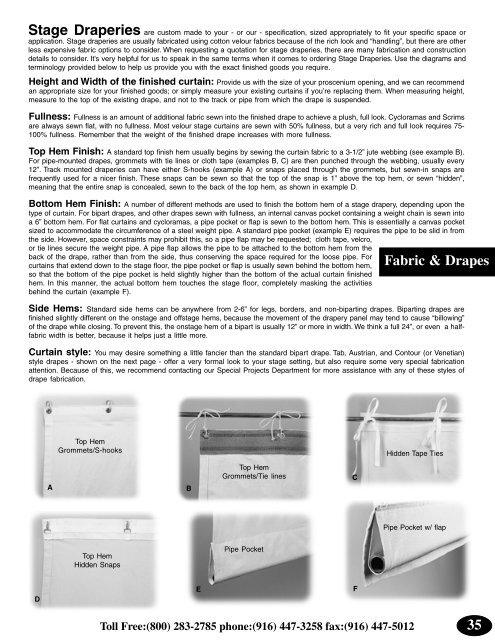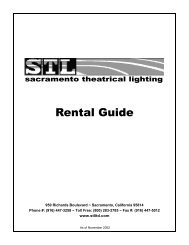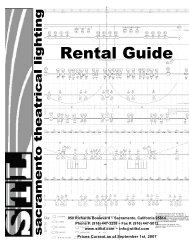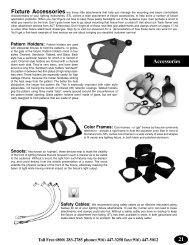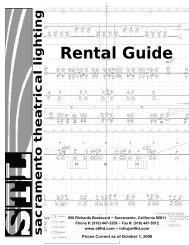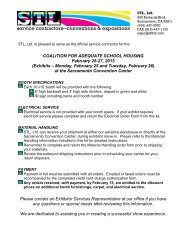Fabric & Drapes - Sacramento Theatrical Lighting
Fabric & Drapes - Sacramento Theatrical Lighting
Fabric & Drapes - Sacramento Theatrical Lighting
Create successful ePaper yourself
Turn your PDF publications into a flip-book with our unique Google optimized e-Paper software.
Stage Draperies are custom made to your - or our - specification, sized appropriately to fit your specific space or<br />
application. Stage draperies are usually fabricated using cotton velour fabrics because of the rich look and “handling”, but there are other<br />
less expensive fabric options to consider. When requesting a quotation for stage draperies, there are many fabrication and construction<br />
details to consider. It’s very helpful for us to speak in the same terms when it comes to ordering Stage Draperies. Use the diagrams and<br />
terminology provided below to help us provide you with the exact finished goods you require.<br />
Height and Width of the finished curtain: Provide us with the size of your proscenium opening, and we can recommend<br />
an appropriate size for your finished goods; or simply measure your existing curtains if you’re replacing them. When measuring height,<br />
measure to the top of the existing drape, and not to the track or pipe from which the drape is suspended.<br />
Fullness: Fullness is an amount of additional fabric sewn into the finished drape to achieve a plush, full look. Cycloramas and Scrims<br />
are always sewn flat, with no fullness. Most velour stage curtains are sewn with 50% fullness, but a very rich and full look requires 75-<br />
100% fullness. Remember that the weight of the finished drape increases with more fullness.<br />
Top Hem Finish: A standard top finish hem usually begins by sewing the curtain fabric to a 3-1/2” jute webbing (see example B).<br />
For pipe-mounted drapes, grommets with tie lines or cloth tape (examples B, C) are then punched through the webbing, usually every<br />
12”. Track mounted draperies can have either S-hooks (example A) or snaps placed through the grommets, but sewn-in snaps are<br />
frequently used for a nicer finish. These snaps can be sewn so that the top of the snap is 1” above the top hem, or sewn “hidden”,<br />
meaning that the entire snap is concealed, sewn to the back of the top hem, as shown in example D.<br />
Bottom Hem Finish: A number of different methods are used to finish the bottom hem of a stage drapery, depending upon the<br />
type of curtain. For bipart drapes, and other drapes sewn with fullness, an internal canvas pocket containing a weight chain is sewn into<br />
a 6” bottom hem. For flat curtains and cycloramas, a pipe pocket or flap is sewn to the bottom hem. This is essentially a canvas pocket<br />
sized to accommodate the circumference of a steel weight pipe. A standard pipe pocket (example E) requires the pipe to be slid in from<br />
the side. However, space constraints may prohibit this, so a pipe flap may be requested; cloth tape, velcro,<br />
or tie lines secure the weight pipe. A pipe flap allows the pipe to be attached to the bottom hem from the<br />
back of the drape, rather than from the side, thus conserving the space required for the loose pipe. For<br />
curtains that extend down to the stage floor, the pipe pocket or flap is usually sewn behind the bottom hem,<br />
so that the bottom of the pipe pocket is held slightly higher than the bottom of the actual curtain finished<br />
hem. In this manner, the actual bottom hem touches the stage floor, completely masking the activities<br />
behind the curtain (example F).<br />
<strong>Fabric</strong> & <strong>Drapes</strong><br />
Side Hems: Standard side hems can be anywhere from 2-6” for legs, borders, and non-biparting drapes. Biparting drapes are<br />
finished slightly different on the onstage and offstage hems, because the movement of the drapery panel may tend to cause “billowing”<br />
of the drape while closing. To prevent this, the onstage hem of a bipart is usually 12” or more in width. We think a full 24”, or even a halffabric<br />
width is better, because it helps just a little more.<br />
Curtain style: You may desire something a little fancier than the standard bipart drape. Tab, Austrian, and Contour (or Venetian)<br />
style drapes - shown on the next page - offer a very formal look to your stage setting, but also require some very special fabrication<br />
attention. Because of this, we recommend contacting our Special Projects Department for more assistance with any of these styles of<br />
drape fabrication.<br />
Top Hem<br />
Grommets/S-hooks<br />
Hidden Tape Ties<br />
A<br />
B<br />
Top Hem<br />
Grommets/Tie lines<br />
C<br />
Pipe Pocket w/ flap<br />
Top Hem<br />
Hidden Snaps<br />
Pipe Pocket<br />
D<br />
E<br />
F<br />
Toll Free:(800) 283-2785 phone:(916) 447-3258 fax:(916) 447-5012<br />
35


